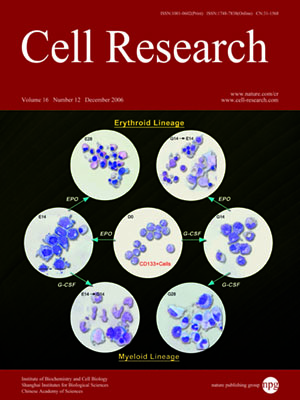
Volume 16, No 12, Dec 2006
ISSN: 1001-0602
EISSN: 1748-7838 2018
impact factor 17.848*
(Clarivate Analytics, 2019)
Volume 16 Issue 12, December 2006: 949-960
ORIGINAL ARTICLES
5-Azacytidine induces changes in electrophysiological properties of human mesenchymal stem cells
Bartosz Balana, Cecilia Nicoletti, Ihor Zahanich, Eva M Graf, Torsten Christ, Sabine Boxberger,Ursula Ravens
Department of Pharmacology and Toxicology, 2Medical Clinic I, Medical Faculty, Dresden University of Technology, Fetscherstr. 74, D-01307 Dresden, Germany
Correspondence: Ursula Ravens(ravens@rcs.urz.tu-dresden.de)
Previously, mouse bone marrow-derived stem cells (MSC) treated with the unspecific DNA methyltransferase inhibitor 5-azacytidine were reported to differentiate into cardiomyocytes. The aim of the present study was to investigate the efficiency of a similar differentiation strategy in human mononuclear cells obtained from healthy bone marrow donors. After 1–3 passages, cultures were exposed for 24 h to 5-azacytidine (3 μM) followed by 6 weeks of further culture. Drug treatment did not induce expression of myogenic marker MyoD or cardiac markers Nkx2.5 and GATA-4 and did not yield beating cells during follow-up. In patch clamp experiments, approximately 10-15% of treated and untreated cells exhibited L-type Ca2+ currents. Almost all cells showed outwardly rectifying K+ currents of rapid or slow activation kinetics. Mean current amplitude at +60 mV doubled after 6 weeks of treatment compared with time-matched controls. Membrane capacitance of treated cells was significantly larger than in controls 2 weeks after treatment and remained high after 6 weeks. Expression levels of mRNAs for the K+ channels Kv1.1, Kv1.5, Kv2.1, Kv4.3 and KCNMA1 and for the Ca2+ channel Cav1.2 were not affected by 5-azacytidine. Treatment with potassium channel blockers tetraethylammonium and clofilium at concentrations shown previously to inhibit rapid or slowly activating K+ currents of hMSC inhibited proliferation of these cells. Our results suggest that despite the absence of differentiation of hMSC into cardiomyocytes, treatment with 5-azacytidine caused profound changes in current density.
Cell Research (2006) 16:949-960. doi: 10.1038/sj.cr.7310116; published online 12 December 2006
FULL TEXT | PDF
Browse 1973


